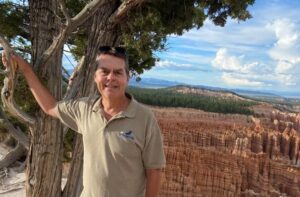From 1999-2010, Roanoke City Public Schools hired me to teach history at Patrick Henry High School (PH). It was a personal and professional blessing in many ways, for my main assignment was teaching history in the Center for the Humanities, a team-taught, honors program. In order to enter, students had to submit good grades, a writing sample, and teacher recommendations. That way, the students in the program both wanted to be there and had the skills and attitude to flourish.
One strength of the program was that each class had two teachers in the room at the same time: one for English and one for history/social studies. The interdisciplinary structure helped students make connections and see “the big picture.”
I started at PH when it was still the original campus layout from the 1960s. Then, after three semesters in trailers (euphemistically called “learning cottages”) during construction, we moved into the new building.
This story took place in the new building, so between 2007-2009.
Since this was several years ago, a few details are paraphrased but the overall gist remains.
Due to some planning oversight, our Humanities class occupied a space originally designed as a science classroom. Thus, it had a black countertop across one side.
Once while tidying up the classroom during planning period, I noticed a pile of manila folders on the countertop. Wondering what they were so I’d know what to do with them, I took a look, and was mystified.
The folders had stacks of 8.5 x 11 white paper inside, with lists of names along the left side and mainly a list of numbers along the right. Adding to the mystery, in several places, instead of a number were the letters “PHS.”
Looking for some meaning, I scanned the left column. They were student names, alphabetically, and I recognized maybe 10-20% of them, mainly those I had taught or knew from the hallway or had heard about.
As for the numbers, they were scattered between threes and twelves. As I recall, roughly 20% were threes, fours and fives; maybe 30% were sixes, sevens and eights; and another 30% nines, tens, elevens and twelves. About 20% or so were “PHS.”
After awhile, a pattern emerged: among the students I knew, most had “PHS” or at least a higher number like ten or eleven. On the flip side, most of the lower numbers were with names I didn’t recognize.
Being in an interdisciplinary program I had more contact with the English department than most history teachers did, so I asked an English teacher what the folders were about.
They had come from an English department meeting, listing the students and their reading levels. I forget if the names were for all PH students grades 9-12, or just the seniors, but I do remember feeling shocked: “You mean all these people are in high school, and lots of them have middle school reading levels, and quite a few are at an elementary school level?”
The English teacher also informed me, “‘PHS’ stands for ‘post-high school’.” So, maybe one-fifth showed reading proficiency expected from a high school graduate.
I felt some professional satisfaction realizing that many of the students I had worked with were “PHS,” reasoning that our robust vocabulary curriculum and many books we had required them to read, write about, and discuss gave them a strong English foundation.
On the other hand, self-selection was at work too. Students had to demonstrate strong skills and positive attitudes to get into the Humanities Center in the first place, and only ambitious students would choose a track that required a lot of extra work and higher standards.
At that point I had been teaching at PH for around eight years, and I couldn’t believe that so many students I saw on campus every day probably had the reading or vocabulary skills of a ten- or eleven-year-old.
“How had they gotten all the way to high school with such weak skills?” I wondered.
To be continued.
–Scott Dreyer

